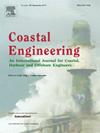Explainable data-driven modeling of suspended sediment concentration at a deltaic marsh boundary under river regulation and storm events
IF 4.2
2区 工程技术
Q1 ENGINEERING, CIVIL
引用次数: 0
Abstract
Sediment supply is a critical factor influencing the evolution of river deltas and deltaic marshes. This study presents an innovative approach using explainable data-driven modeling, specifically integrating bagged regression trees with Shapley additive explanations (SHAP), to predict suspended sediment concentration (SSC) at the boundary of an intertidal salt marsh in the Yellow River Delta. The model achieves high predictive accuracy, with an R2 of 0.978 and an RMSE of 0.099 kg/m3 for training, and an R2 of 0.899 and an RMSE of 0.118 kg/m3 for testing, supported by 5-fold cross-validation and ensemble learning. SHAP analysis identifies significant wave height and SSC from the upper river as the main factors influencing SSC at the marsh boundary. The predominant influence of wave heights over other factors suggests that wave-induced local resuspension governs the sediment supply to the marsh, rather than remote sediment advection from the river mouth, which was previously regarded as the primary source. This may explain the continued expansion of the marshes despite a declining riverine sediment discharge in recent years. Additionally, the developed model links SSC at the marsh boundary to key hydrodynamic parameters, allowing for defining dynamic sediment boundary conditions in modeling marsh evolution under changing environments, instead of using oversimplified, static sediment boundary conditions in common practice. By integrating predictive accuracy with interpretability, this method can provide deeper insights into sediment dynamics of the deltaic marsh, therefore supporting comprehensive management of river regulations and delta resilience building.
河流调节和风暴事件下三角洲沼泽边界悬浮泥沙浓度可解释的数据驱动模型
泥沙供给是影响河流三角洲和三角洲沼泽演化的重要因素。本研究提出了一种创新的方法,使用可解释的数据驱动模型,特别是将袋装回归树与Shapley加性解释(SHAP)相结合,来预测黄河三角洲潮间带盐沼边界的悬浮泥沙浓度(SSC)。在5倍交叉验证和集成学习的支持下,该模型具有较高的预测精度,训练的R2为0.978,RMSE为0.099 kg/m3,测试的R2为0.899,RMSE为0.118 kg/m3。SHAP分析发现,显著波高和上游河流的SSC是影响沼泽边界SSC的主要因素。波高对其他因素的主要影响表明,波浪引起的局部再悬浮控制着沼泽的沉积物供应,而不是来自河口的远距离沉积物平流,后者以前被认为是主要来源。这也许可以解释,尽管近年来河流沉积物排放量减少,沼泽仍在继续扩大。此外,开发的模型将沼泽边界的SSC与关键的水动力参数联系起来,允许在模拟变化环境下的沼泽演变时定义动态泥沙边界条件,而不是在通常的实践中使用过于简化的静态泥沙边界条件。通过将预测准确性与可解释性相结合,该方法可以更深入地了解三角洲沼泽的泥沙动态,从而支持河流法规的综合管理和三角洲弹性建设。
本文章由计算机程序翻译,如有差异,请以英文原文为准。
求助全文
约1分钟内获得全文
求助全文
来源期刊

Coastal Engineering
工程技术-工程:大洋
CiteScore
9.20
自引率
13.60%
发文量
0
审稿时长
3.5 months
期刊介绍:
Coastal Engineering is an international medium for coastal engineers and scientists. Combining practical applications with modern technological and scientific approaches, such as mathematical and numerical modelling, laboratory and field observations and experiments, it publishes fundamental studies as well as case studies on the following aspects of coastal, harbour and offshore engineering: waves, currents and sediment transport; coastal, estuarine and offshore morphology; technical and functional design of coastal and harbour structures; morphological and environmental impact of coastal, harbour and offshore structures.
 求助内容:
求助内容: 应助结果提醒方式:
应助结果提醒方式:


